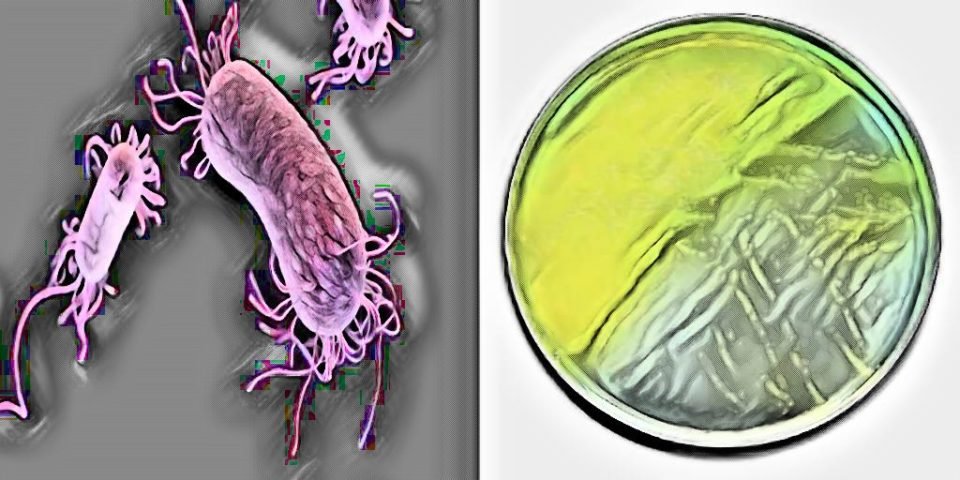Hey, Good to see you here 😀 …… In this Article, We’re gonna discuss in Detail the Morphology & Culture characteristics of Pseudomonas aeruginosa….. If you have any queries, don’t forget to mention in Comments….. Thanks
Morphology of Pseudomonas aeruginosa (P. aeruginosa)
Pseudomonas aeruginosa is a Slender, rod shape (bacillus) bacterium.
The size of P. aeruginosa is about 1.5–3 mm × 0.5 mm (micrometer).
Pseudomonas aeruginosa is arranged singly or in pairs.
Pseudomonas aeruginosa is an actively motile bacterium.
P. aeruginosa is a flagellated bacterium with a polar flagellum, arranged in an amphitrichous manner.
The Pseudomonas aeruginosa is a non – sporing bacterium.
P. aeruginosa is a non – capsulated bacterium but some strains posses slime layer.
Pseudomonas aeruginosa is a Gram -ve (Negative) bacterium.
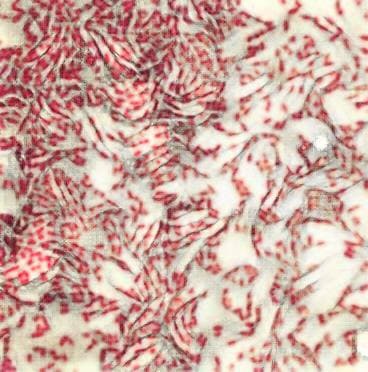
Culture Requirements of Pseudomonas aeruginosa (P. aeruginosa)
Special requirements – Pseudomonas aeruginosa or P. aeruginosa have no complex nutritional requirements and readily grow in an ordinary media like Nutrient Agar medium (NAM). Commonly the NAM & MacConkey Agar medium is used for the cultivation of Pseudomonas aeruginosa in Laboratory.
Optimum temperature – Pseudomonas aeruginosa has a wide range of temperature that is from 4–40°C but the optimum temperature for most of the strains is 37°C and usually cultivated at this temperature in laboratories.
Optimum pH – P. aeruginosa can survive at 5.6– 9.0 pH but the maximum growth observed in between 6.6-7.6 i.e. around slightly acidic to slightly alkaline pH. Also, the pH requirements vary as per the strain of Escherichia col.
Oxygen requirements – Pseudomonas aeruginosa (P. aeruginosa) is an obligate aerobic bacterium i.e. grows only in the presence of oxygen.
There are various culture media used for the cultivation of Pseudomonas aeruginosa (P. aeruginosa) in the laboratory and most commonly the Nutrient Agar medium and MacConkey Agar medium is used, the other media are as follows –
- Columbia Horse Blood Agar medium.
- Sheep Blood Agar medium.
- Tryptic Soy Agar medium.
- Cetrimide Agar Medium (Selective medium).
- The liquid medium (Nutrient Broth medium, TSB medium, etc.).
The Cetrimide Agar medium which is a selective medium for the P. aeruginosa and other species of Pseudomonas consists of a key component Cetrimide which inhibits the growth of many bacteria including gram-positive bacteria & Normal flora while allowing the growth of Pseudomonas species and especially the Pseudomonas aeruginosa.
Culture Characteristics of Pseudomonas aeruginosa (P. aeruginosa)
Cultural Characteristics Nutrient Agar Medium (NAM) Cetrimide Agar medium MacConkey Agar medium Blood Agar Medium
Shape Irregular Circular Circular Irregularly edged circular
Size 2-4 mm 1-3 mm 2-3 mm 2-4 mm
Elevation Low Convex Low Convex Low Convex Flat
Surface Smooth (fresh isolation) ; Mucoid (When slime layer is formed) Smooth (fresh isolation) ; Mucoid (When slime layer is formed) Smooth (fresh isolation) ; Mucoid (When slime layer is formed) Smooth (fresh isolation) ; Mucoid (When slime layer is formed)
Color Greenish blue (due to pigment production) Greenish blue (due to pigment production) Colorless Greyish white
Structure Translucent –Opaque Opaque Transparent Translucent –Opaque
Hemolysis ----- ----- ----- β-Hemolysis (in some strains)
In liquid culture media like Trypticase soy broth or Nutrient broth, the growth of the bacterium occurs as a dense turbidity in the broth medium with a surface pellicle which is further analyzed for the morphology (under the microscope), gram reaction, biochemical tests, and Pseudomonas aeruginosa specific tests.
In Blood Agar medium, some of the strains show beta hemolysis, especially which are isolated from the pathologic conditions whereas those which are isolated from normal persons may or may not show hemolysis on blood agar. It produces Large, flat and irregularly edged circular colonies.
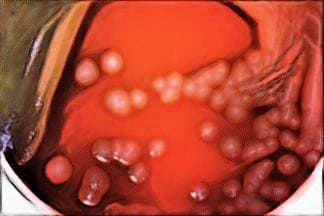
In an ordinary medium like Nutrient Agar medium, Pseudomonas aeruginosa produces a characteristic sweetish odor or a distinctive musty or earthy smell in the medium.
In MacConkey Agar medium, the colonies of Pseudomonas aeruginosa are Colorless due to the lack of lactose fermentation which is of great importance in differentiating P. aeruginosa from other Bacteria present in the specimen, especially from Gram-positive bacteria, E. coli & Klebsiella species which are Lactose fermentors and gives pink colored colonies on MacConkey agar medium.
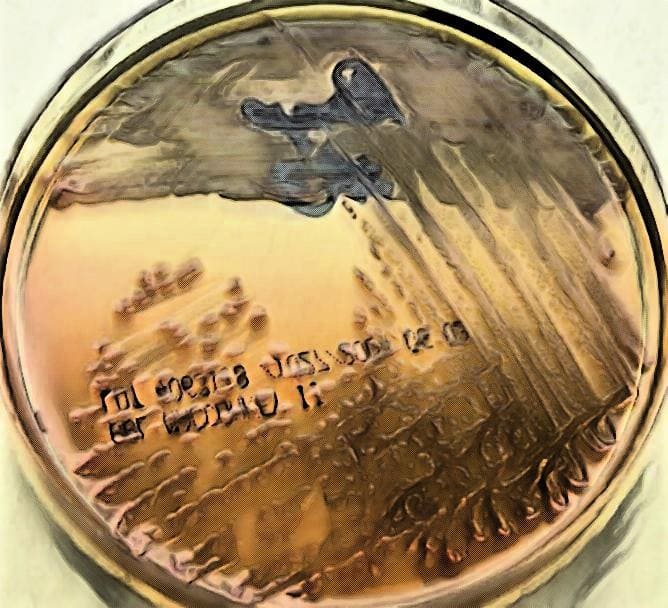
In Cetrimide Agar medium, the selective medium for Pseudomonas aeruginosa, colonies are Medium sized & irregular growth is observed due to the swarming of the bacterium. The pigment production is enhanced and diffused in the medium imparting characteristic greenish-blue coloration to the medium.
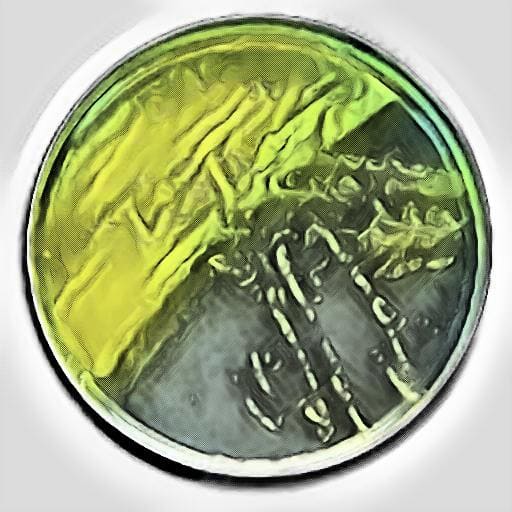
Pigment Production in the Culture of Pseudomonas aeruginosa
In the culture medium, P. aeruginosa produces mainly 4 types of pigments which diffuse out into the surrounding medium and imparts a characteristic color to the medium indicating the suspected growth of Pseudomonas aeruginosa. These are described as below:
NAME OF THE PIGMENT COLOR OF THE PIGMENT
Pyocyanin Bluish-Green
Fluorescein Greenish-Yellow
Pyorubicin Reddish-Brown
Pyomelanin Brown to black
Of the 4 types of Pigments, only the Pyocyanin is important from the diagnostic point of view as Pyocyanin is the only pigment that is not produced by any other species of Pseudomonas but only by the Pseudomonas aeruginosa imparting characteristic color to the medium representing Pseudomonas aeruginosa growth in the medium.
That’s all about the Morphology & Culture characteristics of Pseudomonas aeruginosa (P. aeruginosa)
Frequently Asked Questions (FAQs)
Q1. What is the culture morphology of Pseudomonas aeruginosa?
Pseudomonas aeruginosa appears as a gram-negative, rod-shaped bacterium. It produces a fruity odor and is motile due to the presence of a single polar flagellum. Its colonies appear as smooth, shiny, and bluish-green in color, often exhibiting a characteristic metallic sheen.
Q2. What is the cultural morphology of Pseudomonas aeruginosa?
Pseudomonas aeruginosa has a unique cultural morphology. Its colonies are typically flat, smooth, and circular with an iridescent, bluish-green color. These colonies often produce a characteristic fruity odor and may also exhibit a metallic sheen.
Q3. How do you culture Pseudomonas aeruginosa?
Pseudomonas aeruginosa can be cultured using various methods. The most common method involves inoculating a sterile culture medium, such as nutrient agar, with a sample containing the bacterium. The inoculated medium is then incubated at a temperature of 35-37°C for 24-48 hours. After incubation, the colonies can be observed and identified based on their cultural and morphological characteristics.
Q4. What culture medium is used for Pseudomonas aeruginosa?
Pseudomonas aeruginosa can be cultured on a variety of culture media, including nutrient agar, tryptic soy agar, and MacConkey agar. However, selective media such as cetrimide agar and Pseudomonas isolation agar are commonly used for the isolation and identification of this bacterium.
Q5. What are the culture characteristics of Pseudomonas?
Pseudomonas species are known for their ability to grow on a variety of culture media and under different environmental conditions. They exhibit a range of cultural characteristics, including the production of pigments, such as pyocyanin and pyoverdin, and the ability to form biofilms. Pseudomonas colonies often have a characteristic fruity odor, and some species may exhibit a metallic sheen.
Q6. What color is Pseudomonas aeruginosa culture?
Pseudomonas aeruginosa culture typically appears as iridescent, bluish-green colonies. The green color is due to the production of a water-soluble pigment called pyocyanin. In addition to the green color, the colonies may also exhibit a metallic sheen, which is a characteristic feature of this bacterium.
User Review
( votes)
Laboratory Hub aims to provide the Medical Laboratory Protocols & General Medical Information in the most easy to understand language so that the Laboratory Technologist can learn and perform various laboratory tests with ease. If you want any protocol to be published on Laboratory Hub, Please drop a mail at contact@laboratoryhub.com. Happy Learning!

